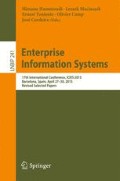Abstract
The main objective behind Workflow systems is to support the definition, execution and control of Workflow processes. A Workflow process defines a set of activities and the specific order in which they should be executed, in order to reach a common objective. Therefore, it is important to manage in the best possible way time and resources. The proposal of this work is to express in a more realistic way the resource allocation mechanisms when human behavior is considered in Workflow activities. In order to accomplish this, fuzzy sets delimited by possibility distributions will be associated with the Petri net models that represent human type resource allocation mechanisms. Additionally, the duration of activities that appear on the routes (control structure) of the Workflow process, will be represented by fuzzy time intervals. To define the execution of activities belongings to minimum and maximum intervals, a time constraint propagation mechanism is proposed. New firing rules based on a joint possibility distribution will then be defined.
L.P. de Rezende—Scholarship CAPES - Proc. \(n^{\circ }\) 99999.001925/2015-06.
Access this chapter
Tax calculation will be finalised at checkout
Purchases are for personal use only
References
Aalst, W.M.P., Hee, K.: Workflow Management: Models, Methods, and Systems. MIT Press, Cambridge (2004)
Aalst, W.M.P.: Verification of workflow nets. In: Azéma, P., Balbo, G. (eds.) ICATPN 1997. LNCS, vol. 1248, pp. 407–426. Springer, Heidelberg (1997)
Hee, K., Sidorova, N., Voorhoeve, M.: Fundam. Inf. 71(2–3), 243–257 (2006)
Martos-Salgado, M., Rosa-Velardo, F.: Dynamic soundness in resource-constrained workflow nets. In: Bruni, R., Dingel, J. (eds.) FORTE 2011 and FMOODS 2011. LNCS, vol. 6722, pp. 259–273. Springer, Heidelberg (2011)
Wang, J., Li, D.: Resource oriented workflow nets and workflow resource requirement analysis. Int. J. Softw. Eng. Knowl. Eng. 23(5), 677–694 (2013)
Ling, S., Schmidt, H.: Time petri nets for workflow modelling and analysis. In: 2000 IEEE International Conference on Systems, Man and Cybernetics, vol. 4, pp. 3039–3044. IEEE (2000)
Kotb, Y.T., Badreddin, E.: Synchronization among activities in a workflow using extended workflow petri nets. In: CEC, pp. 548–551. IEEE Computer Society (2005)
Wang, J., Tepfenhart, W.M., Rosca, D.: Emergency response workflow resource requirements modeling and analysis. IEEE Trans. Syst. Man Cybern. Part C 39(3), 270–283 (2009)
Adogla, E.G., Collins, J.W.: Managing resource dependent workflows. US Patent 8,738,775, 27 May 2014
He, L., Chaudhary, N., Jarvis, S.A.: Developing security-aware resource management strategies for workflows. Future Gener. Comput. Syst. 38, 61–68 (2014)
Deng, N., Zhu, X.D., Liu, Y.N., Li, Y.P., Chen, Y.: Time management model of workflow based on time axis. Appl. Mech. Mater. 442, 458–465 (2014)
Guo, X., Ge, J., Zhou, Y., Hu, H., Yao, F., Li, C., Hu, H.: Dynamically predicting the deadlines in time-constrained workflows. In: Huang, Z., Liu, C., He, J., Huang, G. (eds.) WISE Workshops 2013. LNCS, vol. 8182, pp. 120–132. Springer, Heidelberg (2014)
Lee, D.Y., DiCesare, F.: Scheduling flexible manufacturing systems using petri nets and heuristic search. IEEE Trans. Robot. Autom. 10(2), 123–132 (1994)
Ling, S., Schmidt, H.: Time petri nets for workflow modelling and analysis. In: 2000 IEEE International Conference on Systems, Man, and Cybernetics, vol. 4, pp. 3039–3044. IEEE (2000)
Zhu, D.S., Rong, T.J., Dong, L.G.: An extended time workflow model based on twf-net and its application. J. Comput. Res. Dev. 4, 002 (2003)
Dubois, D., Prade, H.: Possibility Theory. Plenum Press, New York (1988)
Zadeh, L.A.: Fuzzy sets. Inf. Control 8, 338–353 (1965)
Klir, G., Yuan, B.: Fuzzy Sets and Fuzzy Logic: Theory and Applications. Prentice-Hall Inc., Upper Saddle River (1995)
Cardoso, J., Valette, R., Dubois, D.: Possibilistic petri nets. IEEE Trans. Syst. Man Cybern. Part B 29(5), 573–582 (1999)
Dubois, D., Prade, H.: Processing fuzzy temporal knowledge. IEEE Syst. Man Cybern. 19, 729–744 (1989)
David, R., Alla, H.: Discrete, Continuous, and Hybrid Petri Nets, 2nd edn. Springer, Heidelberg (2010)
Julia, S., Oliveira, F.F., Valette, R.: Real time scheduling of workflow management systems based on a p-time petri net model with hybrid resources. Simul. Model. Pract. Theor. 16(4), 462–482 (2008)
Murata, T.: Petri nets: properties, analysis and applications. Proc. IEEE 77(4), 541–580 (1989)
Gondran, M., Minoux, M., Vajda, S.: Graphs and Algorithms. Wiley, New York (1984)
Julia, S., Valette, R.: Real time scheduling of batch systems. Simul. Pract. Theor. 8(5), 307319 (2000)
Acknowledgement
The authors would like to thank CAPES(Coordenação de Aperfei-çoamento de Pessoal de Nível Superior), FAPEMIG (Fundação de Amparo a Pesquisa do Estado de Minas Gerais) and CNPq (National Counsel of Technological and Scientific Development) for financial support.
Author information
Authors and Affiliations
Corresponding author
Editor information
Editors and Affiliations
Rights and permissions
Copyright information
© 2015 Springer International Publishing Switzerland
About this paper
Cite this paper
de Freitas, J.C.J., Julia, S., de Rezende, L.P. (2015). Resource Allocation Mechanisms and Time Constraint Propagation Techniques in Fuzzy Workflow Nets. In: Hammoudi, S., Maciaszek, L., Teniente, E., Camp, O., Cordeiro, J. (eds) Enterprise Information Systems. ICEIS 2015. Lecture Notes in Business Information Processing, vol 241. Springer, Cham. https://doi.org/10.1007/978-3-319-29133-8_11
Download citation
DOI: https://doi.org/10.1007/978-3-319-29133-8_11
Published:
Publisher Name: Springer, Cham
Print ISBN: 978-3-319-29132-1
Online ISBN: 978-3-319-29133-8
eBook Packages: Computer ScienceComputer Science (R0)

